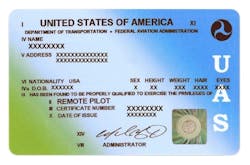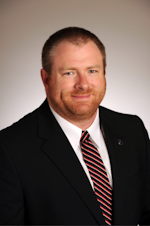The world of Small Unmanned Aircraft Systems (sUAS) or “drones weighing less than 55 pounds” has grown by leaps and bounds over the last few years, with some 9.6 million sUAS sold in the United States as of 2016. As of September 2017, the Federal Aviation Administration (FAA) has awarded some 60,000 people with Remote Pilot Certificates. With so many drones in the field, the question of “How do I legally fly them?” frequently arises. The FAA provides a large collection of free sUAS information and resources on their website www.faa.gov/uas.
On Aug. 29, 2016, the FAA implemented the sUAS rules, officially known as Part 107 of the Federal Aviation Regulations (FAR). FAR 107 contains a special set of rules designed to allow the commercial use of sUAS in the United States. According to the FAA, the “ new small UAS rule enables innovation while maintaining highest levels of safety in world’s busiest and most complex airspace”.
To fly a sUAS outdoors individuals must meet the following FAA criteria:
- Be at least 16 years old
- Be able to read, speak, write, and understand English (exceptions may be made if the person is unable to meet one of these requirements for a medical reason, such as hearing impairment)
- Be in a physical and mental condition to safely operate a sUAS
The FAA rules allow a person to fly a sUAS without a license if it is for recreational purposes only. The FAA considers “recreation” to be a flight for one’s own personal enjoyment. For example, if an individual wanted to take a photo of their home for a holiday card using a drone, this is perfectly legal.
However, one cannot fly a sUAS for an organization, for money, or even pro bono as a donation. So, if a person takes a photo of their house to market it, or takes videos of the local high school football team so plays can be reviewed, these are not recreational purposes. The FAA considers flights for “any reason other than recreation” to be commercial use, and individuals must have a Remote Pilot Certificate under FAR Part 107 in order to do so legally. The good news is that FAR Part 107 allows for a fairly wide amount of commercial operations, excepting a few significant limitations.
To obtain your Remote Pilot Certificate (RPC), you have two options:
- If you are a current FAA Part 61 certificated pilot (meaning at least a Sport or Private Pilot Certificate) with a current medical examination and current Flight Review, then the process is very simple. You begin by completing the online Part 107 small Unmanned Aircraft Systems course on www.faasafety.gov. The course has a brief test at the end. After completion of the course, upload your information to the Integrated Airman Certificate and Rating Application (IACRA) or take it to a Certificated Flight Instructor (CFI) , and then you will receive your Temporary RPC. Your permanent RPC should arrive within 60 days or so. Note that the RPC number will be different from other Airmen’s Certificates, since the RPC is technically a separate certificate.
- If you do not have a FAA Part 61 pilot certificate, the process is different. The FAA allows you to receive your RPC by passing the knowledge test at an approved FAA Testing Center. The knowledge test covers thorough questions on Regulations, Airspace, Weather, Weight and Balance, and Operational Considerations. Expect plenty of memorization questions as well as practical application and map reading. Be warned: it is a fairly rigorous test for those with little aviation knowledge, and each test attempt costs $150. The good news is that self-study programs to help you prepare for the test are available online, through books, or classrooms. Once you pass the test, you can upload your certificate through IACRA or a CFI, and then you will receive your Temporary RPC. Your permanent RPC should arrive within 60 days or so.
As with any other pilot certificate, an RPC can be revoked if you act in a careless or reckless manner. Careless actions can include flying over people, not conducting a proper preflight, flying in high winds, causing manned aircraft to take evasive action, or generally acting with disregard for life or property. Your RPC will have to be renewed every 2 years, but the type (and complexity) of your renewal will depend on whether you have a Part 61 pilot certificate or not. Current FAA Part 61 pilots only need to take the online class again, but non-Part 61s will have to take the knowledge test again for currency — along with that $150 cost.
sUAS can be incredible assets for society as well as providing recreational enjoyment to the user. There are some fairly stringent regulations in place in order to maintain safety for the public on the ground and in the air. By passing your RPC test, you will be more readily prepared not only to fly in a legal way, but also to make solid aeronautical decisions to keep everyone safe while accomplishing a worthwhile mission.
Matt Dowell is the Deputy Director of the Golden Triangle Regional Airport in Columbus, Mississippi. Dowell received both his Bachelor of Commercial Aviation and Masters in Aviation Management from Delta State University in Cleveland, Mississippi. He is an Accredited Airport Executive with over 5 years of airport management experience. He is also a FAA licensed Flight Instructor and Unmanned Aerial Vehicle pilot. In addition, he volunteers with the local Civil Air Patrol.
Brandon Guillot has a MS in Aeronautical Science in Aviation Management and Aviation Safety Systems from Embry-Riddle Aeronautical University and a BS in Aviation Management from Louisiana Tech University; Brandon holds both a FAA Private Pilot and Remote Private Certificate. He is an Accredited Airport Executive with 12 years experience in the Operations, Emergency Management, and Planning departments at two Part 139 airports. He also serves as an Adjunct Assistant Professor for Embry-Riddle Aeronautical University, teaching Airport Operations and UAS Management at the graduate and undergraduate levels. Brandon has over 12 years of recreational and commercial UAS experience and is the owner of Unmanned Aerial Solutions of Arkansas, training UAS pilots in addition to aerial photography services. He has assisted airports and pilots with developing plans for the safe integration of UAS at the local, regional, and national levels, and serves as a member of the FAA Safety Team.





